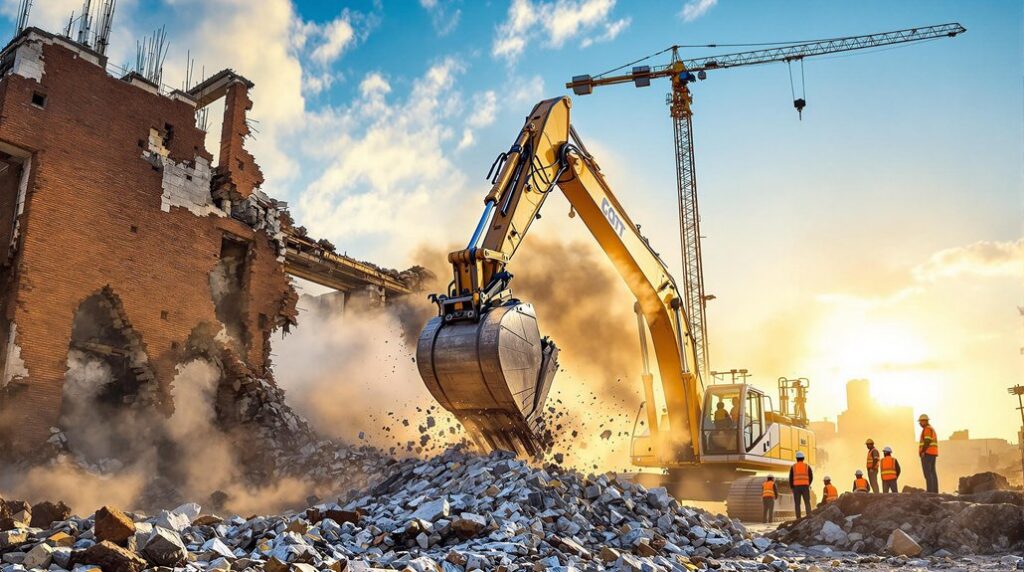Local removal and demolition services play an essential role in site clearance for residential and commercial properties. These professionals guarantee compliance with regional regulations, improve communication, and provide access to necessary equipment and expertise. Their in-depth knowledge of local materials and established community relationships contribute to safer, more efficient projects. By prioritizing sustainability, such services can also minimize waste and lower environmental impact. To understand the removal and demolition process in detail, continue exploring the key considerations involved.
Understanding the Importance of Local Removal and Demolition Services
Understanding the importance of local removal and demolition services is essential for both residential and commercial property owners, especially when you consider the various factors involved in construction projects. These services guarantee that sites are cleared efficiently and safely, minimizing potential hazards. Local professionals are familiar with regional regulations, which helps to avoid legal complications. Additionally, they possess the necessary equipment and expertise to handle materials properly, reducing the risk of accidents. By engaging local experts, you can also benefit from their knowledge of the surrounding environment and community needs. This localized approach not only fosters a smoother project timeline but also contributes to maintaining property values and guaranteeing compliance with safety standards throughout the demolition process.
Benefits of Hiring Local Professionals
When you hire local professionals for removal and demolition services, you tap into a wealth of advantages that can greatly impact your project. Local experts possess in-depth knowledge of regional regulations, ensuring compliance and reducing the risk of costly fines. Their familiarity with local materials and suppliers allows for quicker sourcing, which can streamline your timeline and budget. Additionally, hiring locally often means better communication and accessibility, as they understand the community and its nuances. You'll likely benefit from their established relationships with other local businesses, which can enhance efficiency. Moreover, supporting local professionals fosters economic growth in your area, contributing to a thriving community. Overall, these factors make local professionals a smart choice for your removal and demolition needs.
The Removal and Demolition Process Explained
The removal and demolition process involves several critical steps that guarantee efficiency and safety, particularly when tackling large-scale projects. Initially, you'll need a thorough assessment of the site to identify structures to be demolished and any potential hazards. Next, you'll prepare the area by securing permits and notifying utilities to facilitate safe operations. After that, the actual demolition begins, which may involve mechanical methods or manual labor, depending on the structure's size and materials. Once the demolition is complete, the site must be cleared of debris, requiring proper disposal methods for hazardous materials. Finally, you'll conduct a final inspection to confirm the site is safe and ready for any future construction or landscaping.
Safety Measures and Compliance Regulations
Safety measures and compliance regulations are essential in the removal and demolition industry, as they protect both workers and the public from potential hazards. Adhering to these regulations guarantees a safer work environment. Key measures include proper training, protective gear, and regular safety audits.
| Measure | Description |
|---|---|
| Personal Protective Equipment | Essential gear like helmets, gloves, and goggles. |
| Site Assessment | Evaluating risks before starting any project. |
| Waste Management | Safe disposal of hazardous materials. |
| Emergency Procedures | Clear guidelines for responding to accidents. |
| Compliance Checks | Regular inspections to guarantee adherence to laws. |
Sustainable Practices in Removal and Demolition
As the construction industry evolves, integrating sustainable practices in removal and demolition has become essential for minimizing environmental impact. By adopting these methods, you not only contribute to a healthier planet but also enhance the efficiency of your projects. Here are three key sustainable practices to contemplate:
- Recycling and Reusing Materials: Salvage materials like brick, wood, and metals for future use, reducing waste and conserving resources.
- Implementing Controlled Demolition Techniques: Use precision methods that limit debris and dust emissions, ensuring a cleaner site.
- Utilizing Eco-friendly Equipment: Opt for machinery that minimizes fuel consumption and emissions, aligning with green initiatives.
These practices not only support sustainability but also often lead to cost savings and improved public relations.
How to Choose the Right Local Service Provider
Choosing the right local service provider for removal or demolition tasks can greatly impact the success of your project, especially when considering factors like efficiency, cost, and environmental responsibility. Start by researching providers' reputations; online reviews and testimonials can provide valuable insights into their reliability. Make certain the company you choose is licensed and insured, as this protects you from potential liabilities. Additionally, assess their experience with similar projects to gauge their expertise. Request detailed proposals that outline their methods and timelines to evaluate their approach. Finally, don't hesitate to ask about their sustainable practices, as environmentally responsible providers will prioritize recycling and waste reduction. By carefully considering these factors, you'll be better equipped to make an informed decision for your project.
Cost Considerations for Removal and Demolition Projects
When planning a removal or demolition project, understanding the associated costs is essential for effective budgeting and decision-making. Various factors influence the overall price, and being aware of these can help you avoid unexpected expenses. Consider these key cost components:
- Labor Costs: Skilled workers are necessary for safe and efficient demolition, and their rates can vary based on experience and location.
- Permit Fees: Depending on your project, you may need to secure permits, which can add to your total cost.
- Disposal Fees: Properly disposing of debris often incurs fees, particularly for hazardous materials.
